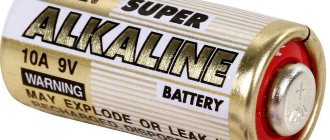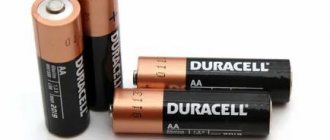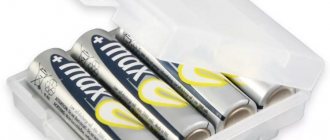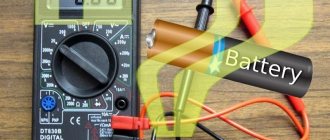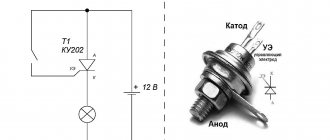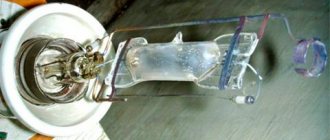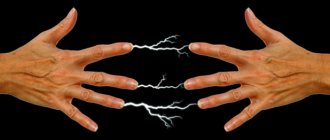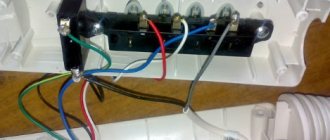Charging methods
- Batteries. These are special devices for charging batteries. They are used to charge alkaline batteries, but salt batteries should never be charged in such a device.
- Connection to the power supply. The battery is connected to the terminals of the power supply, plus to plus, and minus to minus.
- Heating. This method is very simple, but it is considered dangerous, since the battery can simply explode. Most often, hot water is used, which should reach the entire area of the battery.
- Reducing volume. This is an effective method that is used most often. The battery is pressed down with teeth or pliers, which reduces its volume. This method is used only once, after which the battery cannot be used again.
- Boiling in saline solution.
Refilling the battery. The most difficult method, which only a true expert can do.
Knowing how to properly charge batteries, you can significantly extend their life and reuse them in any necessary device.
Without a multimeter
If you don’t have a tester at hand, you can check the battery’s performance in a simpler, but less accurate way. To do this, you need to lift it perpendicular to a horizontal hard surface at a height of 2–3 cm and carefully release it.
If the battery is working, it will fall with a hard sound and, most likely, will remain standing. The exhausted element will make a muffled sound when falling and will tip over.
If the method does not help, increase the height of the battery drop to 20 cm. A charged element will simply fall on its side, but a discharged one may jump several times and fly away from the place of fall by several cm. There is an opinion that this test method only works with alkaline batteries, but There is no exact confirmation of this.
Well, the easiest way to check the performance of a battery is to insert it into one or another device, for example, into a remote control, which requires a minimum residual resource for operation. If the batteries do not work in the remote control, you can safely throw them away.
Battery life
Battery life depends on the load; it is important to know how much energy a household appliance consumes per hour.
- The load is measured in mAh, for example, if the device consumes 20 mAh per hour,
- And the battery reserve is 2000 mAh, then 200 mAh is consumed in 10 hours.
- This means that at this consumption the battery will last for 100 hours of operation.
How to check where is plus and where is minus
If there is no marking on the device, and you need to determine where the positive contact is located and where the negative contact is, then a multimeter is needed to perform this procedure.
To determine the polarity using a multimeter, you need to make the voltage equal to 20V. Connect the black wire to the negative pole, and the red wire to the positive pole.
Then the multimeter turns on. And if one value appears on the device, then the wires that are connected have the correct polarity.
If the value appears with a minus sign, it means you have not connected the wires correctly, so you need to swap them.
If you are using an analog multimeter, then if the wires are connected correctly, the arrow will show the correct voltage, otherwise the arrow will point in the opposite direction.
Multimeter
Battery classification
Batteries differ from each other in their shape and type of chemical reaction.
Batteries may have the following form:
- Cylindrical shape. These are the well-known AA batteries, which are the most popular.
- Barrel. They have a large power reserve.
- Rectangular batteries, they are also called crown batteries.
- Disc form - tablets.
The most powerful of these batteries is the crown, which has a voltage of 9 volts.
As for the type of chemical reaction, the following types are distinguished:
- Salt battery. The power of such a battery is minimal.
- Alkaline, more powerful battery.
- Lithium. Copes with high loads.
Battery for recharging
The battery is only used to recharge alkaline batteries. The device has four compartments; batteries are inserted into three of them, and the battery itself is inserted into the fourth.
It is important to know how long to charge the battery; it usually lasts between five and ten minutes.
After this, you can use the batteries again, but their life will be short. It is best to take a battery with a charge indicator, which is most convenient to use.
- It is best to choose a battery with multiple battery compartments;
- The charger should turn off automatically;
- The greater the power of the device, the better;
- The charger must have a built-in indicator and display;
The cheapest devices are not recommended for use, as they have a short service life and can ruin a good battery. More expensive options are of good quality and are more worth the purchase.
Battery structure diagram
There is an electrode in the center of the battery. It is a mixture of zinc powder, a composition thickener and an electrolyte. Batteries use only high-purity zinc with the addition of several metals. This scheme excludes mercury from their composition.
A brass rod is placed in the zinc. It plays the role of a current conductor. Thanks to this structure, the contact area between the rod and the powder increases. A large supply of the element that forms a negative charge makes it possible to extend its service life.
Plus and minus are separated by a membrane impregnated with zinc. It does not allow the positive and negative components to mix.
The first electrode is a mixture of manganese oxide and graphite. There is 1.5 times more positive substance in an alkaline battery than in a salt battery.
Since gases are not released during operation of the device, the battery case is sealed. It has a safety valve that prevents it from exploding. Alkaline batteries are available in different voltages - from 1.5 to 12 V.
Batteries for charger
Not all batteries can be charged in a charger. Batteries that can be recharged many times are called rechargeable batteries.
On their body there is the inscription “rechargeable battery”; such batteries are more expensive than conventional options. Typically, rechargeable batteries take eight to twelve hours to charge.
Today you can find many types of battery chargers. They are used to recharge batteries of various shapes, but charging must be used carefully; the batteries must not be allowed to overheat.
Of course, recharging batteries is considered the safest. Detailed instructions for charging batteries should be included with the charger.
Salt and alkaline batteries: differences
- It is important to remember that salt batteries are not charged in a charger. If you do not use the battery for a long time, it will be completely discharged in a couple of years. Salt batteries are very susceptible to temperature changes, they have a small capacity and a short service life. These batteries cannot withstand high loads.
- Alkaline batteries have better performance. They are not sensitive to temperatures, work much longer, have a large capacity and are suitable for recharging in a charger.
According to the rules, only rechargeable batteries can be charged in the charger, but if you maintain an interval of five to ten minutes, you can charge a regular alkaline battery in the same way. It is important to remember not to increase the charging time, as the battery may explode.
What you need to know
Before you start charging your battery directly, you need to know the following:
- Only special chargers can perform a 100% charge of the battery, and home methods of charging the battery will provide only a partial charge.
- When using home methods, you need to take into account the current, voltage, and resistance, since at low values of these parameters charging will not be performed, and at high values the battery may completely fail.
- During the period of charging the battery, it is necessary to monitor the condition of the battery. If the battery starts to get very hot, this process must be stopped immediately.
- It is also necessary to monitor the current value. This procedure is performed using a multimeter.
If direct charging of the battery is performed incorrectly, it may be damaged. For this reason, such charging can be carried out by those who know how to use a multimeter and know how to find the voltage, and can also distinguish the positive contact from the negative one.
Charging AA batteries
There are many different ways to charge batteries that are used at home. But not all of them are safe, so you should treat them with caution.
- Traditional methods can work, but it is best to turn to them in the most necessary cases.
- After charging, a regular battery does not last long, this time is enough to purchase new batteries.
- If you charge an alkaline battery in a charger, you should never allow it to overheat.
Knowing how to charge a battery makes it easy to get them working again and use the batteries again before they run out again.
Only rechargeable batteries are suitable for repeated charging, so it is best not to risk your health and immediately buy only those batteries that are safe to charge. Lithium batteries should not be charged; they will explode under physical stress and can cause serious injury.
Element heating
The battery will recover from simple heating and this is scientifically proven. The method can also be applied to ordinary finger elements. Do not rush to throw away the seemingly “lifeless” charging case. It’s better to put it in hot water for 20 seconds, dry it and insert it into the socket.
In winter, the shriveled element can be heated on a heating radiator if the water supply temperature in it is quite high. Yes, use whatever options you like, just so that the battery warms up, then it will again be able to produce a charge. Except for fire, of course.
During the period of total shortage, batteries for tape recorders were often restored by boiling them in salt water. They took off the wrapper, put it in a saucepan and boiled it for a certain time, then took it out, wrapped it in electrical tape and inserted it into the player.
A machine that can change color
Have you seen this video yet? BMW came up with an interesting technology, although probably for its widespread use the legislation on...
This is what blog traffic looks like in 2022 by month. This is more than THREE MILLION views per month, including not only those logged into LiveJournal, but also any views from search engines. At the same time, about a MILLION visitors come per month. Google Analytics statistics for the month 2022 (...
The inscription on the case rechargable means that this is a battery. If it only lasts a couple of dozen cycles, then you are not using it correctly.
If the batteries are discharged by less than 25%, then they can be recharged several hundred times to a voltage of 1.42 volts, if they are discharged by more than 25% and less than 50%, then they can be recharged up to 50 times to a voltage of level 1, 32 volts. A severely discharged battery can be recharged no more than 20 times.”
Don't throw away dead batteries: 3 ways to revive a battery
If you disassemble this battery, you will find an anode and a cathode inside - these are electrodes, one of which is positively charged and the other negatively charged. They are located inside a container that is filled with electrolyte and all this is in a metal casing.
Expert opinion
Viktor Pavlovich Strebizh, lighting and electrical expert
Any questions ask me, I will help!
If you disassemble this battery, you will find an anode and a cathode inside - these are electrodes, one of which is positively charged and the other negatively charged. If there is something you don’t understand, write to me!
Photos of the best battery manufacturers
Share with friends

